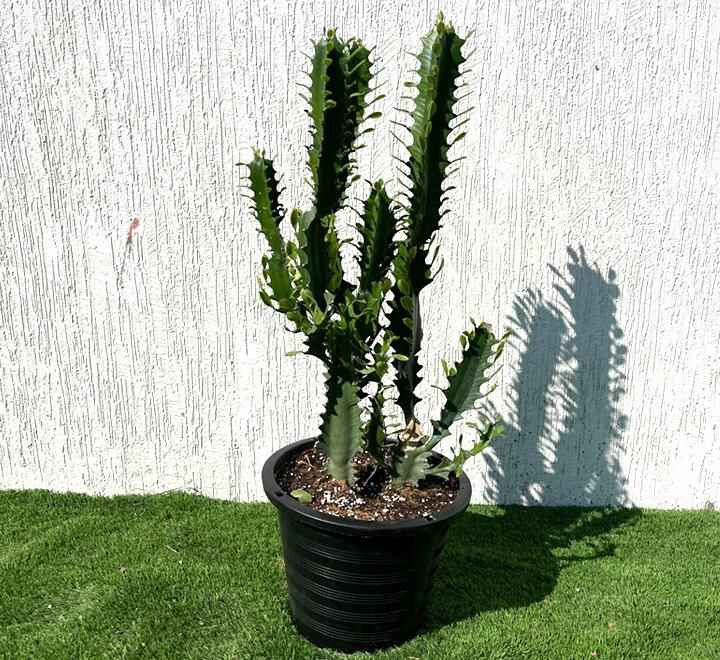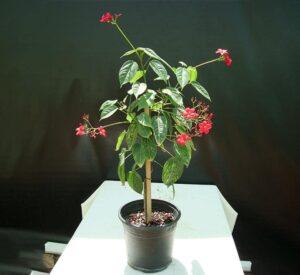Euphorbia Trigona 60 – 80cm
Euphorbia trigona
Euphorbia trigona, also known as Mottled Candlestick, is a succulent plant native to tropical Asia. Its adaptability to dry regions is evident through its water storage tissue and compact form, resembling cacti. Widely cultivated worldwide, it often escapes cultivation, forming dense thickets in various tropical areas.
- Max Height: 3-5m
- Spread: 3m
- Origin: Asia
- Family: Euphorbiaceae
- Common Name: candelabra cactus, candelabra plant, dragon bones, false cactus, hatrack cactus, milkstripe euphorbia, mottled candlestick.
- Drought Tolerance: High
- Salinity Tolerance: Low
- Sun Tolerance: High
- Wind Tolerance: Medium
- Water Requirement: Low
- PH Level: Basic
- Pest Tolerance: High
- Disease Tolerance: High
- Growth Rate: Slow
- Fragrance: No
Note: All parts of the plant contain a poisonous milky latex
Deliverable
- Healthy plant in its pot with premium soil
- All the tips and tricks for expert-level care
- Safe arrival guaranteed
Reasons to buy from us
- Guaranteed quality
- Careful handling
- On time delivery
- Support
- Telephone support
- Live chat support
- Trained staff
د.إ75.00
Euphorbia Trigona
Euphorbia trigona, also known by a plethora of other names such as Mottled candle stick tree, Milk striped euphorbia, and Candelabra Cactus, is a fascinating succulent plant that has captured the attention of plant enthusiasts and botanists alike. In this comprehensive guide, we delve into the various aspects of Euphorbia trigona, from its origins to its growth requirements and unique characteristics.
Origin and Distribution
Originating from Asia, Euphorbia trigona is found growing wild in tropical regions. However, due to its resilience and adaptability, it has been widely cultivated in various parts of the world, including the West Indies, Florida, and many other tropical areas. Interestingly, it has also escaped cultivation in several regions, forming dense thickets in its wake.
Morphology and Adaptations
Euphorbia trigona boasts succulent stems with water storage tissue, a characteristic adaptation to thrive in arid and dry regions. Similar to cacti, these plants have evolved to have compact forms with reduced surface area, thereby minimizing water loss. Moreover, the green stems of Euphorbia trigona serve as efficient substitutes for leaves in the process of photosynthesis, further enhancing its ability to withstand harsh environmental conditions.
Common Names and Synonyms
The versatility and popularity of Euphorbia trigona are reflected in its numerous common names and synonyms. From Candelabra Cactus to Dragon Bones and Hatrack Cactus, each name hints at a unique aspect of this remarkable plant. These names not only add to its mystique but also highlight its diverse cultural significance across different regions.
Growth Characteristics
Euphorbia trigona exhibits a range of growth characteristics that make it a desirable addition to any garden or landscape. With a maximum height of 3-5 meters and a spread of 3 meters, it can make a striking focal point in any setting. Despite its slow growth rate, its drought tolerance, high pest resistance, and low water requirements make it an ideal choice for xeriscaping projects.
Related Product: Cactus San Pedro
Environmental Requirements
Understanding the environmental requirements of Euphorbia trigona is crucial for ensuring its optimal growth and health. Thriving in high-sun conditions and exhibiting low salinity tolerance, this plant is well-suited to arid climates with well-draining soil. Additionally, its high pest and disease tolerance further contribute to its resilience in various environmental conditions.
Cultivation and Care
Cultivating and caring for Euphorbia trigona requires attention to detail and a basic understanding of its needs. Planting in well-draining soil and providing ample sunlight are essential for promoting healthy growth. Additionally, regular watering, especially during the growing season, will help maintain hydration levels and prevent dehydration. Pruning may be necessary to control its size and shape, but caution must be exercised due to its toxic latex sap.
Unique Features and Uses
Beyond its ornamental value, Euphorbia trigona possesses several unique features and potential uses. Additionally, its striking appearance and architectural form make it a popular choice for landscaping and interior decoration, adding a touch of exotic elegance to any space.
Conclusion
In conclusion, Euphorbia trigona is a captivating succulent plant with a rich history and a myriad of names. From its origins in Asia to its widespread cultivation worldwide, this resilient species continues to fascinate and inspire. With its unique adaptations, striking appearance, and cultural significance, it truly deserves its place as a beloved icon of the plant kingdom.
| Dimensions | 20 cm |
|---|





